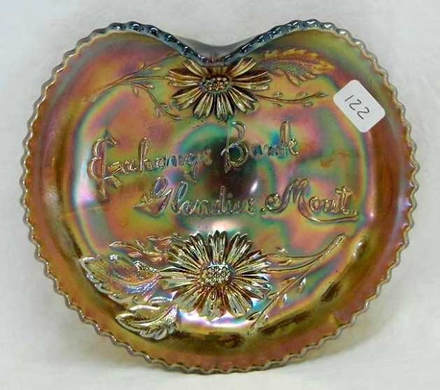Bank On It! Exchange Bank - The Story Behind The Glass
Based on our original material written in January 2015
The Exchange Bank advertising piece was made by Fenton in amethyst, in the small (6 inch) plate, handgrip plate and bowl shapes only. The words “Exchange Bank Glendive Mont” (for Montana) are flanked by the floral motifs of Fenton’s Garden Mums pattern (which was utilised for several other advertising patterns). The back pattern features the familiar “Wide Panel” exterior.
|
Exchange Bank 6 inch plate in amethyst, Fenton.
Courtesy Seeck Auctions. |
Above: Exchange State Bank at 100-104 South Merrill Avenue in Glendive.
The whole block of buildings is known as the Dion Building, and the Exchange State Bank is in the foreground on the corner. Photo and information courtesy of the Frontier Gateway Museum, Glendive. |
|
It’s fascinating to study the photo of the actual bank shown above. The bank’s name on the façade of the building is indistinct, but what is clear is that the name is slightly different. On the advertising piece it simply states “Exchange Bank” whereas on the building we see “Exchange State Bank”. The story behind the name helps us to pinpoint the approximate date when the advertising piece was made. The Exchange Bank in Glendive was founded in 1901, at a time when many banks were privately owned. During the October 1907 Wall Street “Panic” many savers lost their deposits when thousands of banks collapsed. Exchange Bank (which was not incorporated) responded to the “Panic” with the ad shown on the right that was placed in the Yellowstone Monitor newspaper in 1908. Its purpose was to assure their depositors of the bank's worth and safety of its deposits. The bank however needed to adapt and change; the two newspaper ads below show perfectly how this took place. On the left below, the “responsibility” (the “worth” of the owners) of Exchange Bank was $200,000 in June 1911. Just one month later the bank changed its name to the Exchange State Bank of Glendive - and it had become formally capitalised as a State Bank with a capital of $75,000. |
So, it is clear from this history of the bank that Fenton must have made the advertising piece some time prior to its name change.
Most likely it would have been produced between 1908 and 1910. In fact Marion Hartung in her Book V quoted a letter (written to a customer of the bank in 1962) in which the customer said that her mother received one of these pieces as a present in around 1909.
One wonders if it the bank actually had it made in order to advertise the bank’s solidarity and worth in the aftermath of the 1907 Wall Street “Panic”.
Most likely it would have been produced between 1908 and 1910. In fact Marion Hartung in her Book V quoted a letter (written to a customer of the bank in 1962) in which the customer said that her mother received one of these pieces as a present in around 1909.
One wonders if it the bank actually had it made in order to advertise the bank’s solidarity and worth in the aftermath of the 1907 Wall Street “Panic”.
Exchange Bank handgrip plate (left) and bowl, both in amethyst. Courtesy Seeck Auctions.
Finally, a little bit of background on Glendive itself, which owes its establishment to the railroad and ranching / agricultural industries. The town lies in the lower Yellowstone Valley, in north eastern Montana close to the border with North Dakota. It enjoyed an "oil boom" from the 1950s into the 1980s.
An interesting quote from the Montana Historical Society adds a little more:
“Glendive began as a steamboat landing on the Yellowstone River and as a railroad centre in the middle of prime stock country… The Glendive Times encouraged newcomers, even promising single women ‘a right smart chance to catch on to husbands’. By 1884 the town supported three hotels, several churches, a school, a courthouse, at least ten saloons, and a variety of other commercial enterprises.”
Read more of The Stories Behind The Glass in Carnival Glass Times






